One of the major challenges facing MSD through the years has been correcting problems with old sewer lines. The problems fall into three basic categories: deterioration, improper connections, and outmoded design features. Wet weather aggravates all three.
As sewer lines deteriorate, they develop cracks. Wastewater can escape into the ground through these cracks, causing problems. But far greater problems are caused by groundwater leaking into the sewer lines through these cracks — a condition called infiltration.
Infiltration has been a serious problem in many older subdivisions with sanitary-only sewer lines. Water leaking into the lines can quickly overload them, causing backups into basements.
In some instances, especially in the sandy ground in downtown and western Louisville, infiltration can wash surrounding dirt into the sewer lines. This creates a growing cavity underground, and may lead to a cave-in.
The second basic problem, inflow, is caused by improper stormwater connections to the sanitary-only sewers. Downspouts and basement sump pumps are the major offenders; driveway and walkway drains also cause problems. The reason: sanitary sewers were not designed to carry stormwater; they’re simply not large enough.
Modern materials have made it possible to repair many deteriorating sewer lines without digging them up and replacing them. In the 1980s and early 1990s, several major old sewers were rehabilitated by "sliplining" — inserting a plastic lining inside the old pipes. Another method involves inserting a special fabric "sock" into the lines, inflating it so that it hugs the walls, then impregnating it with plastic resin.
In the late 1980s, MSD stepped up its inflow and infiltration program, surveying neighborhoods where backups were common to try to determine the sources of stormwater entering sanitary sewers. In areas where the problems were especially severe, special equipment was used to seal the cracks in the sewers or reline the pipes. This reduced infiltration substantially, but infiltration through customers’ leaky lines and inflow from customers’ improper connections often remained a problem.
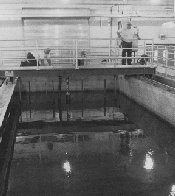
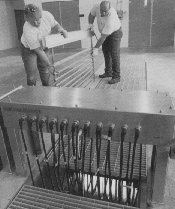
MSD Photos by Martin E. Biemer
Overflows
The outmoded design features that create the worst problems are overflows into streams and the Ohio River — from both combined storm and sanitary sewers and sanitary-only sewers.
Combined sewer overflows are the most common and the most troublesome, because they simply do what the old-time engineers designed them to do: dump the excess water into the streams during heavy rainstorms.
The federal clean-water program began to target combined sewer overflows in the late 1980s. In 1988, MSD began an engineering survey of its 670 miles of combined sewers, detailing the locations and functions of 121 overflows. In 1997, MSD estimated it could cost $1.1 billion to eliminate and replace the combined sewers — a daunting cost. Efforts were under way to identify ways to reduce or eliminate the pollution from the overflows without replacing all the lines.
Two projects in the mid-1990s were designed to approach the problem in different ways. In an eastern Louisville neighborhood overlooking Cherokee Park, MSD separated the storm and sanitary sewer systems to eliminate a relatively small overflow that emptied into Beargrass Creek inside the park. And several miles away, MSD planned a special pretreatment plant to remove the solid waste from the water flowing from a large overflow across Newburg Road from Bellarmine College.
While combined sewer overflows were designed years ago to function during wet weather, sanitary sewer overflows were designed strictly for emergencies. Unfortunately, inflow and infiltration have made discharges from these overflows a routine problem during heavy rains.
In 1995, MSD received a $25,000 federal grant to help finance a demonstration project to reduce the pollution from sanitary sewer overflows; MSD pledged to spend another $100,000 on the project.
Combined Sewer Overflows
Combined sewer overflows act as safety valves along the old combined storm and sanitary sewers, dumping excess water into streams during heavy rains.
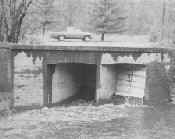

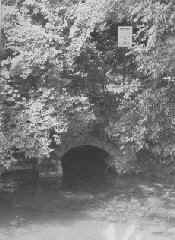
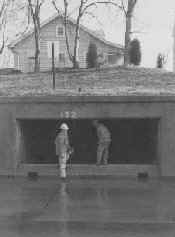
MSD Photos by Martin E. Biemer
MSD History continued - Financing


